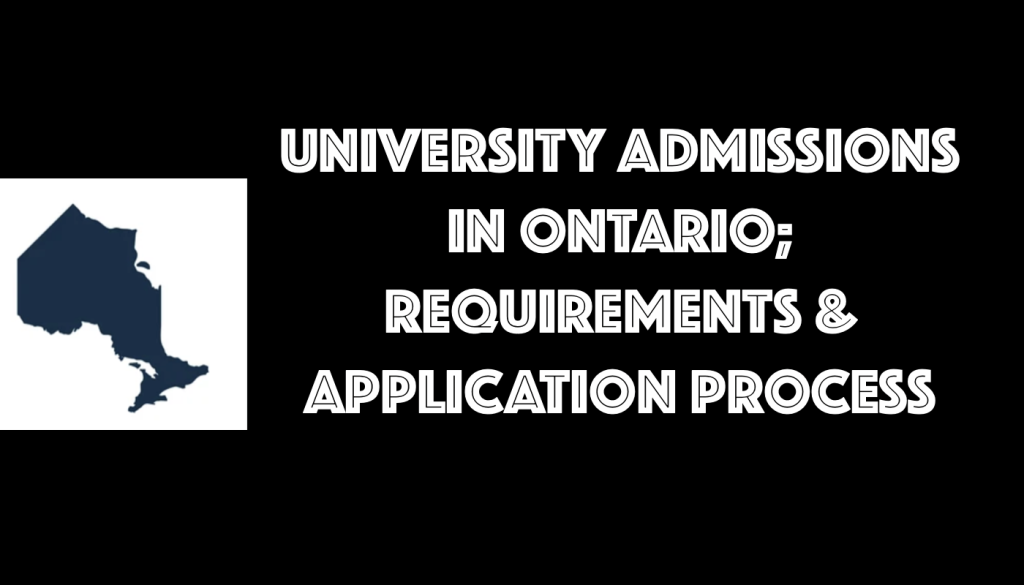University admissions in Ontario is a significant milestone for students aspiring to pursue higher education. Ontario boasts a robust university system with numerous institutions offering a wide range of programs. In this comprehensive guide, we will delve into the requirements and application process for university admissions in Ontario, providing valuable insights and tips to help prospective students navigate this important journey.
Table of Contents
University Admissions in Ontario: Requirements and Application Process
Introduction to University Admissions in Ontario
Ontario is home to world-renowned universities known for their academic excellence and diverse program offerings. Students have the opportunity to choose from a wide range of disciplines, including arts, sciences, business, engineering, and health sciences. Understanding the university admissions process is crucial for prospective students to make informed decisions and ensure a smooth transition to their desired institutions.
Choosing the Right University
Selecting the right university is a crucial decision that can shape one’s academic and career path. Students should consider various factors such as program offerings, campus culture, faculty reputation, location, and extracurricular opportunities. Thorough research, attending university fairs, and speaking with current students or alumni can provide valuable insights into finding the best fit.
Read Also: Everything you need to Know About all the Universities in Ontario
Admission Requirements for Ontario Universities
To gain admission to an Ontario university, students must fulfill specific requirements. Generally, these requirements include a high school diploma or equivalent, completion of specific prerequisite courses, and minimum grade expectations. Different programs or faculties may have additional admission requirements such as portfolios, interviews, or supplementary applications. It is essential for students to review the specific requirements for their desired programs to ensure they meet the criteria.
Application Process for Ontario Universities
The application process for Ontario universities is streamlined through the Ontario Universities’ Application Centre (OUAC). Students create an OUAC account and submit their applications online, including personal information, academic transcripts, and any required supporting documents. It is crucial to carefully review and follow the application instructions for each chosen institution. Paying attention to application deadlines is of utmost importance to ensure consideration for admission.
Read Also: How to Apply to Universities in Ontario
Deadlines and Important Dates
Ontario universities have specific application deadlines for different admission categories, such as early admission, regular admission, and international student admission. It is vital for students to be aware of these deadlines and submit their applications in a timely manner. Additionally, there are specific dates for submitting supplementary documents and accepting offers of admission. Students should maintain an organized timeline to ensure they meet all the necessary deadlines throughout the application process.
Supplementary Applications and Portfolios
Certain programs or faculties in Ontario universities may require supplementary applications or portfolios. These additional requirements allow applicants to showcase their skills, experiences, and achievements beyond academic transcripts. Students should carefully review the program-specific requirements and allocate sufficient time to prepare and submit supplementary materials to strengthen their applications.
Scholarships and Financial Aid
Financing a university education is a significant consideration for many students. Ontario universities offer various scholarships, grants, and bursaries to support students financially. It is crucial to research and understand the available financial aid options and their respective application processes. Students should pay attention to scholarship deadlines and explore external scholarship opportunities as well.
Transferring to Ontario Universities
Students transferring from other institutions or colleges may have questions about the credit transfer process. Ontario universities have specific policies and procedures regarding credit transfer. It is important for transfer students to review the credit transfer guidelines of their chosen universities and ensure a smooth transition of credits earned from their previous institutions.
English Language Proficiency Requirements
International students seeking admission to Ontario universities may need to demonstrate their English language proficiency through accepted tests such as IELTS, TOEFL, or others. Some students may be eligible for exemptions or alternative methods of demonstrating proficiency. International students should carefully review the English language requirements of their chosen universities and plan accordingly.
Tips for a Successful Application
To increase the chances of a successful application, students should focus on presenting their best selves. This section will provide tips for writing a compelling personal statement or essay, securing strong reference letters, and preparing for university admissions interviews, if applicable. By emphasizing the importance of authenticity, self-reflection, and thorough preparation, students can enhance their applications and stand out from the competition.
Understanding Admission Decisions
Receiving admission decisions can evoke a mix of emotions. This section will discuss the different types of admission offers, including conditional offers, deferred offers, acceptances, rejections, and waitlist outcomes. Students will gain insights into interpreting admission decisions and understanding their implications. Additionally, we will provide guidance on appealing admission decisions if necessary.
Preparing for University
Once students receive an offer of admission, they embark on the exciting journey of preparing for university life. This section will outline the steps to take after receiving an offer, including orientation programs, registration processes, and academic planning. Students will also gain insights into preparing mentally and emotionally for the transition, seeking support services, and exploring extracurricular opportunities.
Conclusion
Navigating the university admissions process in Ontario can be a challenging yet rewarding experience. By understanding the requirements and application process, prospective students can make informed decisions and present strong applications to their desired universities. Through thorough research, timely preparation, and utilizing available resources, students can increase their chances of securing admission and embarking on a transformative academic journey. Remember, the university admission process is not just about getting in—it is about finding the right fit, pursuing passions, and unlocking a world of opportunities.

